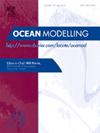The introduction of observation-based wave physics into the wind-wave model WAM: Wave assessments for a semi-enclosed basin
IF 2.9
3区 地球科学
Q2 METEOROLOGY & ATMOSPHERIC SCIENCES
引用次数: 0
Abstract
This study presents the successful integration of ST6 observation-based source term physics into the WAM Cycle 7 wind-wave model, marking the first comprehensive validation and comparison with the existing wave physics ST3 and ST4 of WAM, with a specific focus on the Black Sea. Overall, validations demonstrate consistent and satisfactory performance across all three source term physics, aligning with findings from previous studies using different wave models in various regions. Minor discrepancies exist. ST3 excels in representing significant wave height, crucial for wave power applications, while ST4 and ST6 best reproduce TM02 mean wave period and mean wave direction, impacting Stokes drift direction and thereby drift simulations. Validation metrics unaffected by bias confirm the similarity of the three physics, ruling out calibration issues. Evaluations of ERA5 wind forcing reveal larger errors induced by wind compared to source terms, emphasising the significance of wind quality and model calibration over physics choice. During extreme events, the physics exhibit similar performance, although wind speeds remain relatively low compared to the global ocean. Studies indicate greater discrepancies among physics in larger-scale scenarios with increased fetch, prevailing swell, or hurricanes, where ST6 demonstrates superior performance, while ST4 fares better in low-wind conditions. These findings showcase the need for the examination of these scenarios in the new WAM Cycle 7 version.
基于观测的波浪物理在风浪模型WAM中的引入:半封闭盆地的波浪评估
本研究成功将基于ST6观测的源项物理整合到WAM Cycle 7风浪模型中,首次与WAM现有的海浪物理ST3和ST4进行了全面验证和比较,并以黑海为研究对象。总体而言,验证表明所有三个源项物理性能一致且令人满意,与先前在不同地区使用不同波模型的研究结果一致。存在一些小的差异。ST3擅长表现显著波高,这对波浪能应用至关重要,而ST4和ST6最能再现TM02平均波周期和平均波向,影响Stokes漂移方向,从而影响漂移模拟。不受偏差影响的验证指标证实了三种物理的相似性,排除了校准问题。对ERA5风强迫的评估显示,与源项相比,风引起的误差更大,强调风质量和模式校准比物理选择更重要。在极端事件中,物理表现出类似的表现,尽管风速与全球海洋相比仍然相对较低。研究表明,在更大范围的情况下,在风速增加、盛行浪或飓风等情况下,ST6表现出更好的性能,而ST4在低风条件下表现得更好。这些发现表明需要在新的WAM周期7版本中检查这些场景。
本文章由计算机程序翻译,如有差异,请以英文原文为准。
求助全文
约1分钟内获得全文
求助全文
来源期刊

Ocean Modelling
地学-海洋学
CiteScore
5.50
自引率
9.40%
发文量
86
审稿时长
19.6 weeks
期刊介绍:
The main objective of Ocean Modelling is to provide rapid communication between those interested in ocean modelling, whether through direct observation, or through analytical, numerical or laboratory models, and including interactions between physical and biogeochemical or biological phenomena. Because of the intimate links between ocean and atmosphere, involvement of scientists interested in influences of either medium on the other is welcome. The journal has a wide scope and includes ocean-atmosphere interaction in various forms as well as pure ocean results. In addition to primary peer-reviewed papers, the journal provides review papers, preliminary communications, and discussions.
 求助内容:
求助内容: 应助结果提醒方式:
应助结果提醒方式:


